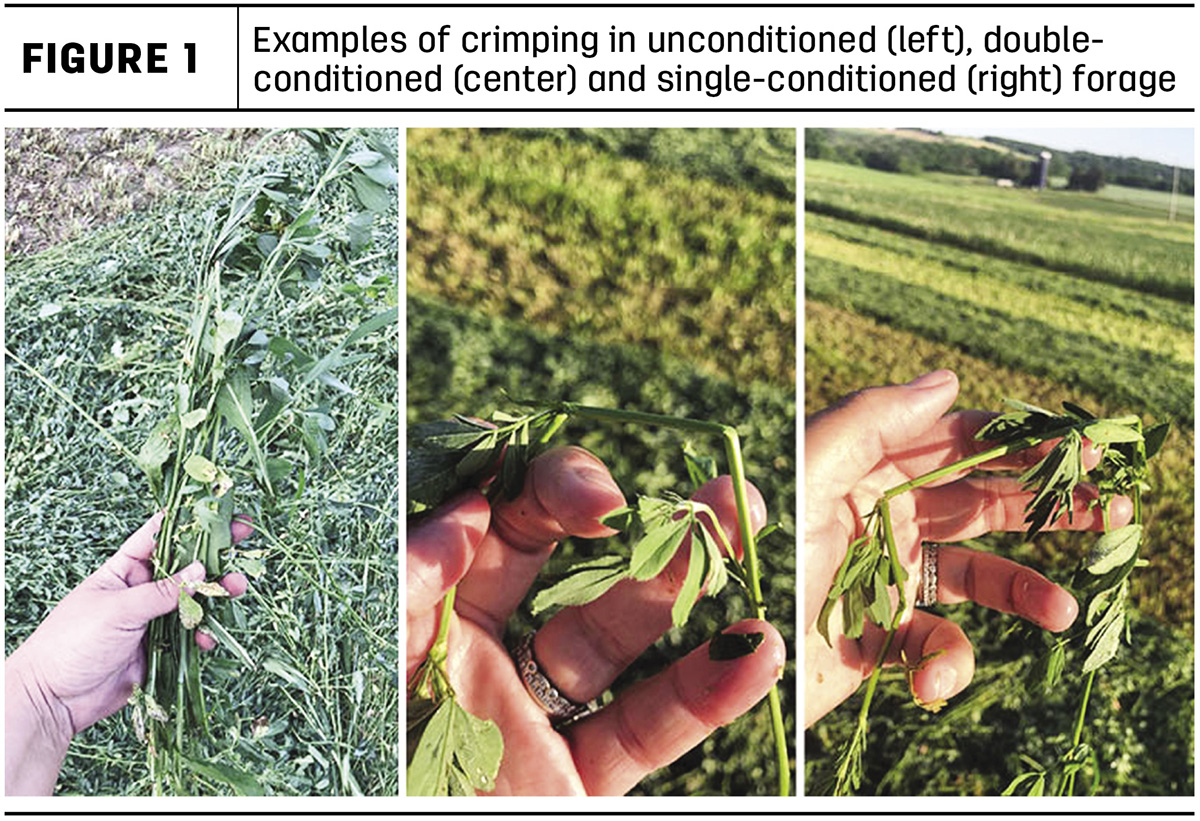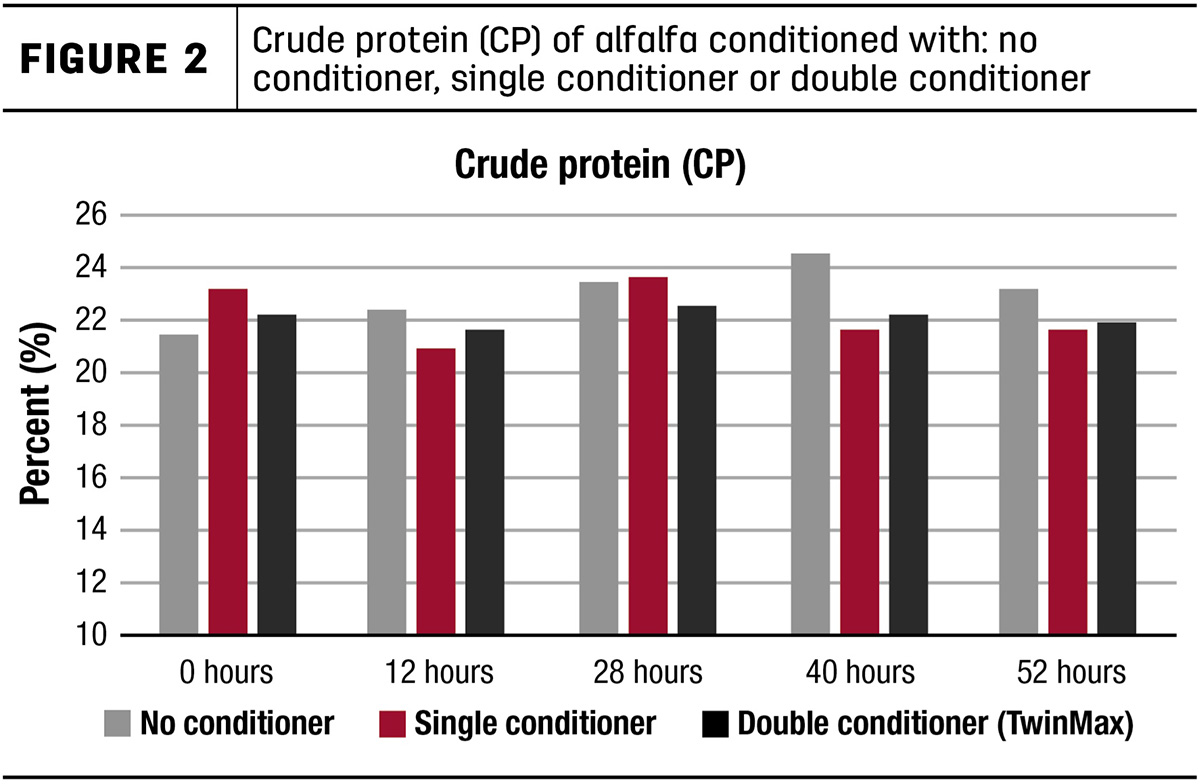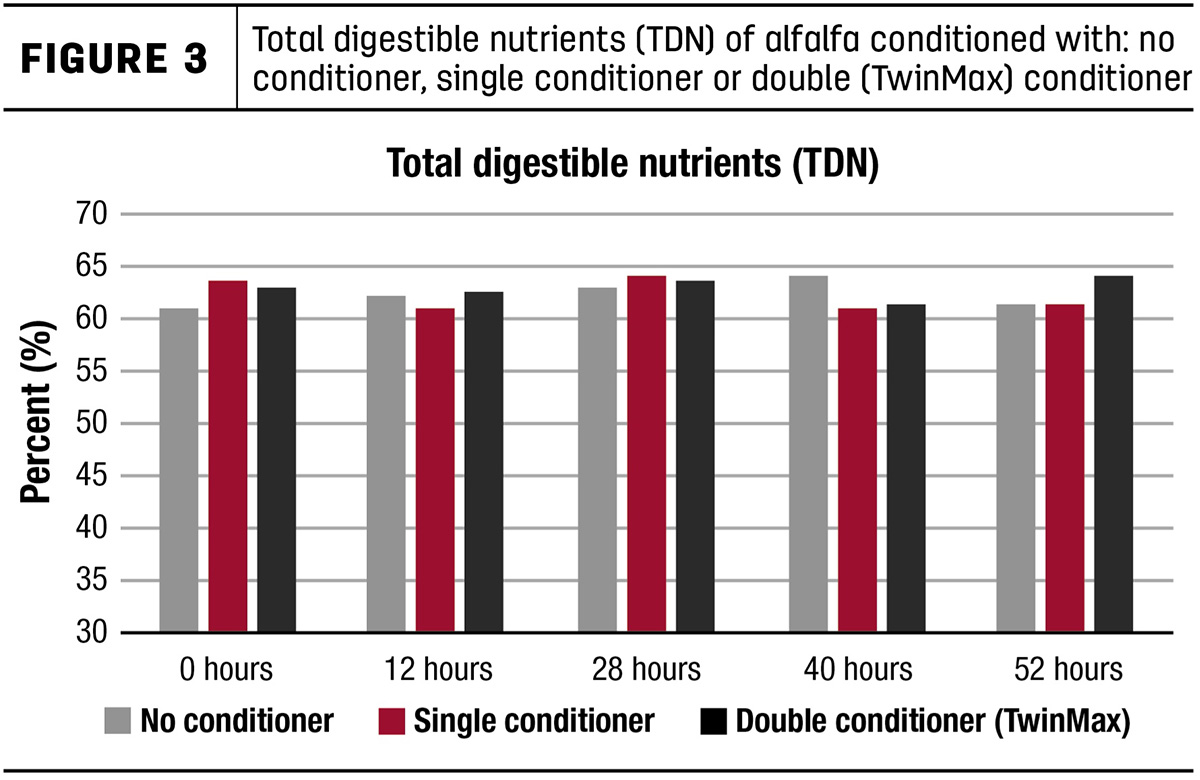Research has proven that adding a conditioner to the mowing process can improve drydown efficiency. Just how much value conditioning can add depends on crop, field conditions and other hay processes. Roller conditioners crimp forage at set intervals, usually every 3 to 4 inches. A double conditioner crimps the plant stem every 1.5 to 2 inches, allowing faster dissipation of moisture through the crimped stem for faster drydown – about six hours in our recent field study.
Examples of crimping
AGCO agronomists conducted a field study that looked at the effect of double, single and no conditioner on drydown rate and forage quality on a second-cutting alfalfa monoculture in Wisconsin. The team used two Hesston by Massey Ferguson WR9970 windrowers, one with a 9316D as its double conditioner example and one with a 9316S representing both single and, with the rolls opened up, no conditioner. Windrowers were operated at 10 mph and 2,100 rpm with a 2-inch cutting height above the soil surface on all treatments.
A note on the weather – the area experienced high humidity during the study, and the threat of rain ended the study at 52 hours despite high moisture levels in some of the forage.
Field study results
No conditioner
An operation might forgo a roller conditioner for many reasons. Key among these are acreage and crop type. Roller conditioner options are limited on the compact pull-type mowers favored by smaller producers. Additionally, operations producing fine-stem grass forage might find more success with a tine or impeller conditioner. Research has shown tine conditioners help to break up the waxy cuticle in grasses and increase drydown efficiency by macerating the leaf and stem, allowing moisture to leave the crop sooner. However, these impellers can cause leaf loss in legume forage, resulting in reduced forage quality in mixed or pure alfalfa stands. At this time, hay tool manufacturers have not provided a way to easily change out conditioner types, so farmers must make a choice based on their operational goals and crop type.
Regardless of reasoning, not conditioning, according to this field study, results in the longest drydown times (Figure 1). At mowing, all forage was approximately 75%-78% moisture.

The project was to allow all treatments to dry down to 15% moisture, ideal for dry hay. As with real-world conditions, the study faced time and weather constraints. In the end, the unconditioned treatment never got below 34% moisture before it was baled and wrapped for baled silage.
Crude protein (CP) was approximately 2% greater from the 12-hour point through the conclusion of the study (52 hours) at each time collection point for unconditioned alfalfa. However, the unconditioned forage never reached a moisture favorable for dry hay. Despite the CP being slightly greater at each collection period, when measured on a moisture basis, the unconditioned alfalfa only had 1% greater protein value than the conditioned alfalfa (Figure 2). Because favorable moisture was never achieved, the final collection taken with this treatment was significantly wetter.

Single conditioner results
On the other hand, conditioned forage, both single and double, immediately began drying down faster than the unconditioned treatment. The single-conditioned treatment maintained a drydown rate of approximately 1% per hour.
Additionally, both conditioned treatments had 3% greater total digestible nutrients (TDN) immediately after mowing (0 hours) compared to unconditioned forage (Figure 3). During the drydown process, TDN in unconditioned forage and single-conditioned forage evened out by the last collection period (52 hours). It is worth noting, however, that at this point the single-conditioned forage was at 20% moisture compared to the unconditioned sample’s 32%.

Double conditioner results
Overall, the study determined that double conditioning provided the most benefit when it came to drydown rates and forage quality. At the 24-hour mark, double-conditioned forage was about 20% drier than the unconditioned treatment and about 5% drier than single-conditioned forage. Throughout the study, double-conditioned forage remained 3%-6% drier than single-conditioned, with a drydown rate of 1.3% per hour. The double-conditioned treatment reached 15% moisture five to six hours sooner, which makes a big difference when weather becomes a factor.
The double-conditioned treatment also had a 2% greater TDN at the 52-hour collection point. This field study will be repeated in a different location with different environmental conditions to verify findings. For now, though, it’s important to note that double-conditioned forage provided a faster drydown while retaining TDN.
Selecting the right conditioner for operational goals
This study proved that using a double conditioner in alfalfa resulted in a faster drydown rate. In an application where every moment counts, imagine the benefits of baling six hours. Assuming a 1% dry matter loss for every 4.8 hours forage lies on the ground prior to baling, as previous research has shown, farmers could see an improvement of approximately 1%-2% dry matter yield. With a yield of 5 tons per acre, that factors out to an additional 100 pounds or $11 an acre, assuming a sale price of $220 a ton.










